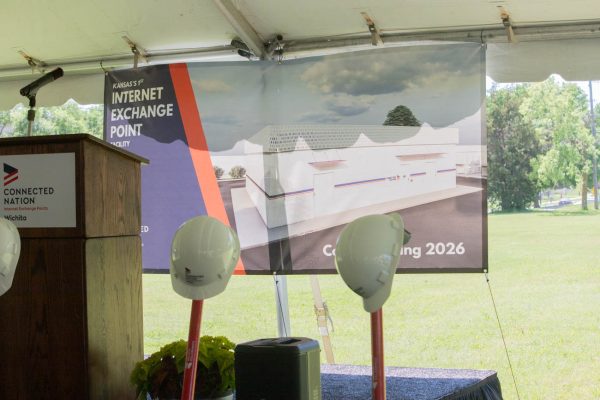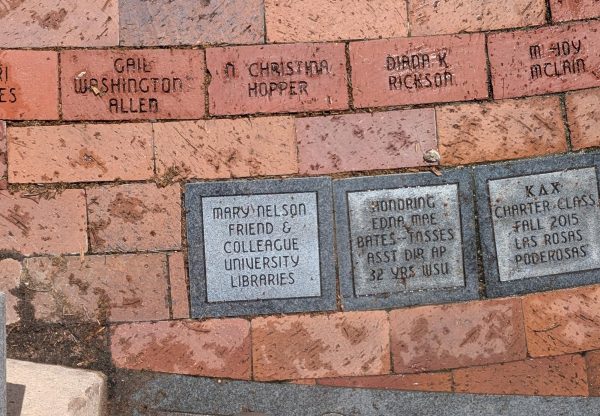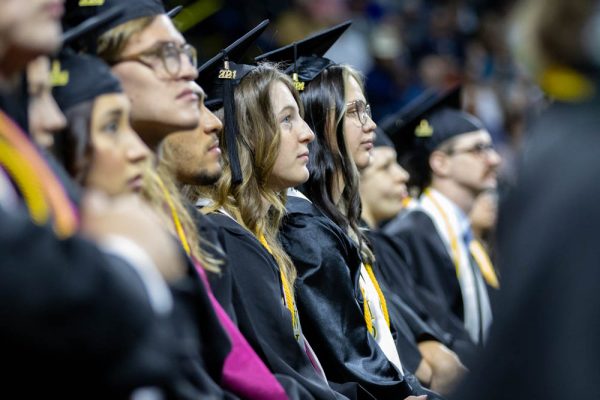Air Capital enthusiasts believe in resilience of aviation industry
One minute, the aviation industry is soaring high over the clouds, and the next, it’s in a nosedive. The turbulence in the industry, however, has yet to impact the bigger picture.
In spite of the recent layoffs at Spirit AeroSystems due to the failure of the Boeing 737 Max and the COVID-19 pandemic, industry devotees have faith in a brighter future. Wichita State is helping create that future.
WSU is no novice when it comes to the world of aviation. Following the emergence of aviation in Wichita, WSU founded the department of aeronautical engineering in 1928, later changing its name to the department of aerospace engineering in 1988.
The program is the seventh oldest in the nation. Professor and Chair of the Aerospace Engineering Department Leonard Scott Miller believes the heritage of the program is an immense draw for prospective students.
“The program started back when astronautics and rocketry were still sort of science fiction,” Miller said mid-February. “What’s pretty cool is that four years after the program started, one of our first graduates was Dwane Wallace, who was the nephew of Clyde Cessna. Later on, Dwane became president of Cessna Aircraft Company.”
As a cooperative education program, WSU’s aerospace engineering program offers partnerships and co-ops with major aircraft enterprises such as Boeing, Cessna Aircraft Company, Learjet, Airbus, NASA, and Spirit AeroSystems.
Junior aerospace engineering student Linda Harl said the program has been quite beneficial for her.
“The opportunities available to me would not have been possible without this program,” Harl said. “In addition to an undergraduate research position as a NASA Jumpstart student, the aerospace department has done everything in their power to ensure my success by facilitating interactions with faculty and staff.”
Harl said the program has prepared her for success outside of the classroom.
“The department emphasizes an industry-ready mindset by physically communicating with campus partners — a mindset that is truly unparalleled,” she said. “I can see the effects of this mindset even now as I attend career fairs, as I am no longer just talking about my classwork but speaking about projects and experience that pertain to my field of interest.”
Former WSU student and current Spirit AeroSystems employee Elisa Acosta said her time in the program helped her get her dream job.
Acosta graduated from the university in 2015 with a degree in aerospace engineering and a minor in mathematics.
“WSU’s aerospace program was and still is a top-tier program,” Acosta said. “The program allowed students to use labs, wind tunnels, and to be hands-on throughout courses. I even got to take a senior design class where I was able to design, build, and fly a small-scale airplane. A lot of students don’t get that experience. Most schools don’t have that benefit.”
While at WSU, Acosta also held a student internship with Spirit AeroSystems. This opportunity secured her a full-time position after graduation. After nearly five years with the company, Acosta said she wouldn’t dream of taking another career path.
Currently, Acosta’s official title is composite materials and processes engineer. She ensures the components that go into making the aircraft are properly built and of high quality.
She said her biggest accomplishment so far has been seeing her hard work come to fruition during the test flight of the first plane she worked on, the Boeing 777X.
On the 777X, Acosta worked specifically on the nacelle of the aircraft, a component located on the wing of the aircraft that can contain the engines, fuel, and other equipment.
Before the takeoff, Acosta said she thought to herself, “Oh God, I hope it flies.”
After the 777X successfully landed and completed its first test flight, she breathed a sigh of relief.
“Seeing that plane fly was actually a really big deal,” Acosta said. “It was the first plane I had started work on in 2015, and now, five years later, it’s flying,” she said. “It was a weird feeling seeing a plane I had a part in making, fly. It’s surreal. I don’t know how else to describe it.”
Beyond WSU’s aerospace engineering program, the National Institute of Aviation Research (NIAR) is also a major entity in the industry.
Established in 1985, NIAR is the nation’s largest nonprofit, university-based aviation research center. The center conducts research for many high-profile clients, including the Department of Defense, NASA, and the Federal Aviation Administration.
On campus, NIAR offers job opportunities for its nearly 260 student employees. Students get real-life experience, form relationships, build their resumes, and come graduation, have an advantage when looking for a job.
“It’s an experience that a lot of times students can’t get anywhere else,” said Tom Aldag, director of research and development at NIAR. “They’re not here to do academic work. They’re here to do work. I have students doing high-tech machining, making fixtures, correcting wind tunnel models, and even some doing robotic programming. We tend to keep the bar high and expect a lot.”
Aldag speaks from personal experience. Growing up around airplanes, he learned how to fly when he was only 16-years-old. He attended WSU and while working on his aerospace engineering degree, took a student internship at Beechcraft. He was later hired on at Beechcraft, where he stayed for eight years before taking another job at Cessna.
“I worked on the coolest airplanes,” Aldag said. “I was around airplanes every day. I was flying all the time. I loved airplanes and I loved my job.”
In 2007, Aldag joined NIAR, where his main goal is to be a resource for the aviation industry. He attests that without his college career and real-world, student experience, his career path would have looked much different.
In recent years, WSU and NIAR have partnered with WSU Tech to expand the capabilities of the college for the future of aviation.
WSU Tech now offers the first two years of a baccalaureate degree for a variety of majors. This feature creates a pathway for many students planning to pursue a four-year degree later on. This is especially true for the field of aerospace engineering.
“In collaboration with the College of Engineering and NIAR, engineering students and graduate students from Wichita State are working on industry-related research alongside WSU Tech students that are becoming educated and skilled in entry-level production work,” WSU Tech President Sheree Utash said.
WSU Tech has four research labs that offer hands-on experience for students.
The WSU campus also has the National Center for Aviation Training (NCAT). This facility offers students the opportunity to partake in real-world, applied training in the fields of general aviation manufacturing, and aircraft and power plants mechanics. Students can gain experience for jobs in the industry ranging from sheet metal assembler to composite fabricator to machinist.
On top of her role as WSU Tech president, Utash serves as WSU’s vice president of workforce development. In this role, she works closely with Airbus, Spirit AeroSystems, Learjet, Textron, and other companies involved in the aviation industry’s supply chain.
“The connection to students is key in the industry,” Utash said. “It reinforces higher education to be a microcosm of the community of which it lives and to be more engaged in business and industry. The students are how they are going to build their future workforce. Education ultimately drives a more highly competitive and globally competitive workforce.”
WSU Tech has nearly 2,500 students in its aviation-related programs.
“This is an extremely unique period of time for the aviation industry and no one should be discouraged for the outlook of the aviation industry,” said Utash Feb. 24, before COVID-19 struck the airline industry. “The outlook for aviation is still very, very strong. There should be nothing that would make people shy away from a career in aviation.”
For nearly a century, the industry has experienced as many triumphs as it has tribulations.
The economic peaks and valleys of aviation have become synonymous with the industry. The recent valleys created by the Spirit AeroSystems’ layoffs and COVID-19 will become another chapter of local aviation history.
“One thing I’ve always been told about the aerospace/aircraft industry is that it’s extremely cyclical,” Acosta said in late April. “It’ll have massive upturns and similar downturns. There will always be a demand for air travel.”
Aldag shares Acosta’s belief in the resilience of the industry.
“Over the years, the aviation industry has experienced a tremendous growth,” Aldag said. “There is a huge need for aircrafts. Even with the valleys, aviation has a big forecast as the industry continues to change and adapt. There are a lot of new airplanes and designs coming out. There’s urban air mobility, space, airlines, supersonics, and even hypersonics. The industry is diverse, advancing, and growing.”
Despite the recent hardships, the aviation industry is backed by those that love it.
“When flying, I get to see things no one else has ever seen before,” Aldag said. “I remember one time I was flying over the northern Oklahoma panhandle where the old Santa Fe Trail tracks used to run. I looked down and it was like seeing a superhighway in the middle of nowhere. It doesn’t get any better than that. There’s nothing quite like aviation. Once you’re in, you’re addicted.”













